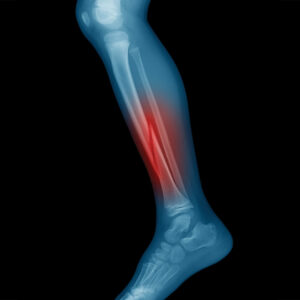What Is a Stress Fracture?

Stress fractures are hairline cracks in the bone that can be challenging to detect and diagnose because they’re so small and usually occur over time. However, there are things you can do to prevent and avoid stress fractures. Dr. Danielle Magrini, fellowship-trained pediatric sports medicine specialist at Orlin & Cohen, explains how stress fractures happen and how being aware of your risk factors can help you prevent such injuries to stay active, healthy, and safe.
Understanding How Stress Fractures Happen
Stress fractures are part of a spectrum of bone stress injuries (BSI). These injuries happen in the microarchitecture of the bone in two common ways:
- “Healthy-ish” bone gets repetitively pushed beyond its limits with inadequate periods of rest for remodeling. When this happens, these consistent loads damage the internal microarchitecture of the bone. Stress fractures often begin with swelling and pain, especially when the bone is loaded, a condition known as a stress reaction. Eventually, if stress does not subside, a collective and definitive break, known as a stress fracture, can occur. These injuries are most common among endurance athletes, like runners.
- Unhealthy bone gets a more “normal” force applied to it, but cannot withstand the pressure due to poor bone quality. This frequently happens to menopausal women with low bone density or individuals with degenerative bone conditions like osteoporosis.
Related reading: How to keep your bones healthy.
Risk Factors for Bone Stress Injuries (BSI)
Bone stress injuries are most common in athletes and typically appear in the lower extremity, between the hip and the toes.
During puberty, a young adult who plays competitive sports is more likely to develop BSI. That’s because rapid changes in height typically outpace the natural development of bone mineral content. A young athlete’s commitment to practice and competition is high, but their bones are still vulnerable and developing.
Peri-menopausal and menopausal women also have to be aware of BSI because of declining estrogen levels, a bone-protecting hormone, which can create bone health issues.
Intrinsic risk factors
Many risk factors can lead to bone stress injuries. These risks are typically classified into two categories, intrinsic or extrinsic. Intrinsic risks are factors we can’t control and include:
Genetics
Your parents have passed down certain genes to you. Science Daily reports that certain genes you might’ve gotten from your family could make you more likely to suffer from a stress fracture.
Sex
Males and females have different risk profiles, and in general, men tend to have higher bone density than women.
Medical history
Your medical history is a combination of your personal health history and your family’s. An orthopedist can review your medical history and advise if it puts you at higher risk for stress fractures.
Extrinsic risks
Your extrinsic risk factors are things you can adjust. Your orthopedist can advise you on preventative measures you can take to avoid a stress fracture.
Type of sports played
People who play high-impact sports, like basketball, tennis, dance, or gymnastics, are more likely to experience a stress fracture, says Mayo Clinic. One way to prevent a stress fracture is to make sure you’re wearing proper footwear. If you’re a runner, take a look at this checklist to make sure you’re getting all the support you can from your shoes.
No matter what sport you play, reduce your risk of injury by doing the following:
- Take time to warm up and stretch before more intense physical activities – and afterward to cool down.
- Use the proper technique – if you’re not sure, consult an athletic trainer or physical therapist.
- Take time off – allow one day per week for rest so your body can recover.
- Add stretching exercises to your daily fitness plan for increased flexibility.
Nutrition
Watching what you eat is another way to make sure your bones stay strong. Having a diet that’s rich in calcium, Vitamin D, and protein can help you maintain and improve bone health. Incorporating potassium into your diet enhances how your body processes calcium, and can improve bone density.
Learn more ways to improve your bone health.
Hormone health
Your hormones are chemical messengers that coordinate numerous different functions in your body. Children’s Hospital of Philadelphia says that parents of young, athletic girls need to pay attention to their daughter’s menstrual cycle.
Missed or irregular periods aren’t something to shrug off because it might mean she’s not taking in enough calories to support a regular menstrual cycle. Hormonal changes, like a period, are tied to the development of bone mass. But if these changes don’t happen properly, the bones become weaker, leaving more risk for injury.
Sleep hygiene
Poor sleep habits can lead to aches and pains. Especially if you’re an athlete, your body needs time to recover and get ready for the next day of exercise. Here are five things you can do tonight to get a good night’s sleep.
Stress Fracture Treatment
If you’re suffering from a stress fracture, seek treatment. During your appointment, your orthopedist will do a thorough physical exam to look for limping and other gait issues, tenderness, swelling, discoloration, or pain. Your orthopedist will also perform several muscle tests and impact maneuvers.
If a bone stress injury is suspected, your orthopedist will begin by recommending an X-ray. However, sometimes stress fractures are so thin they might not appear. If that’s the case, your orthopedist might recommend further diagnostic imaging, such as magnetic resonance imaging (MRI), which can provide a more detailed image. Once your orthopedist has diagnosed your injury, they’ll work with you to create a treatment plan tailored toward you and your goals.
Don’t let a stress fracture leave you sidelined. Contact us to learn how we can help.



